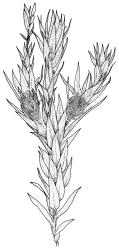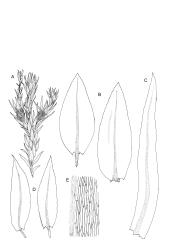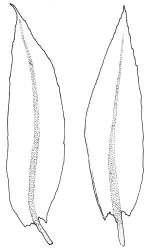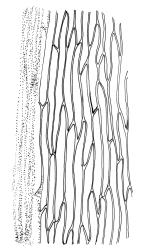- ≡ Mnium crudum Hedw., Sp. Musc. Frond. 189 (1801)
- ≡ Webera cruda (Hedw.) Fürnr., Flora 12(2 Ergänzungsblätter): 35 (1829)
Plants blue- to white-green with a conspicuous red-brown stem, strongly lustrous when dry, usually forming dense turves. Stems variable in length, to at least 35 mm, unbranched, red-brown, in cross-section angled, with incrassate cortical cells and a conspicuous central strand, beset with red-brown and papillose rhizoids. Leaves sparse and distant below, becoming more crowded and larger towards shoot tip, erect or erect-spreading, little altered when dry, ovate-lanceolate to lanceolate, acute, crenulate to bluntly denticulate near apex, entire below, mostly plane at margins, slightly decurrent, 2.5–3.5 × 0.8–1.2 mm (smaller on lower stems; longer in perichaetia and perigonia); upper laminal cells linear-rhombic, mostly c. 120–210 × 12–15 µm, thin-walled, not altered at apex, becoming ± wider but otherwise little altered towards insertion. Costa ending well below the leaf apex, red near base, in cross-section semi-circular on abaxial surface, with median guide cells and two stereid bands. Axillary gemmae nil.
Dioicous or paroicous. Perichaetia terminal, the ♀ leaves narrowly lanceolate, strongly pigmented near insertion, longer and usually more erect than vegetative leaves, lacking paraphyses. Perigonia terminal and conspicuous, the ♂ leaves widely spreading, otherwise as perichaetial leaves, with many antheridia but lacking paraphyses. Setae one or sometimes two, yellow- or red-brown, flexuose, variable in length (mostly 12–22 mm); capsules inclined to horizontal due to curvature of upper setae when moist, often suberect when dry, oblong-cylindric or elongate-pyriform, with a neck shorter or equal to the urn, pale red-brown, (2.5–)3–5 mm; annulus revoluble; operculum conic or umbonate. Exostome teeth pale, lanceolate, narrowly bordered, very finely papillose on outer surface, strongly trabeculate on inner surface; endostome with a high basal membrane, with perforate segments nearly the height of the teeth and nodose, mostly paired cilia. Spores 24–27(–32) µm, brown.
Crum & Anderson 1981, fig. 244 h–k; Shaw & Ramsay 2013, unnumbered fig.
The strongly lustrous and blue- to white-green of the leaves combined with conspicuous red-brown stems and costae, and marked decurrencies, make this species easily recognisable.
Pohlia cruda is similar in many ways to P. nutans but differs from it by its sheen, its mostly dioicous sexuality (and the presence of terminal perigonia in most populations), and mostly thinner-walled laminal cells.
Plants of P. cruda are likewise similar in colour to P. wahlenbergii (both have pale leaves and red stems), but the lustre in P. cruda usually precludes confusion. When fruiting, the longer (mostly 3–5 mm) oblong-cylindric or elongate-pyriform capsules of P. cruda contrast with the distinctly pendent and much shorter (mostly 1.5–2 mm) capsules of P. wahlenbergii.
NI: South Auckland (Maungapōhatu, Mt Pirongia), Wellington (Ōhutu Ridge, Mt Ruapehu); SI: Nelson, Marlborough (Cat Creek, Mt Fyffe, Inland Kaikōura Range), Canterbury, Westland (Pegleg Creek), Otago, Southland (Takahē Valley, Gertrude Valley); Ch; A.
Nearly cosmopolitan. Tasmania*, mainland Australia*, Patagonia*. Crum & Anderson (1981) considered it to be widespread in both the northern and southern hemispheres.
On mineral or humic soil over marble, limestone, greywacke, and lava (andesite?). Often in sheltered crevices and often at stream margins. On the South I. this species seems to favour, but is not restricted to, areas with calcareous, or at least cation-rich rock types, and is most frequent in montane to alpine habitats near to and east of the Main Divide; it appears to be absent in lowland areas on the West Coast. No material from Stewart Island has been seen, but this is probably a collection artefact. Documented from 1220 m (Ōhutu Ridge) to 1400 m (Mt Ruapehu) on the North I. On the South I. ranging from 183 m (Hunters Hills, Canterbury L.D) and c. 350 m (Sugarloaf on Banks Peninsula in Canterbury L.D.) to at least 1900 m (Pisa and Remarkable Ranges, both Otago L.D.) Occurrences below c. 500 m elevation are infrequent. Bartramia papillata, Distichium capillaceum, Grimmia pulvinata, and Philonotis scabrifolia are common associates.









